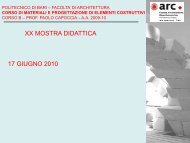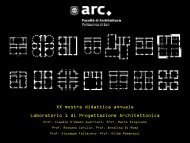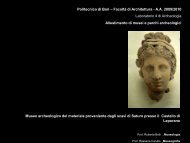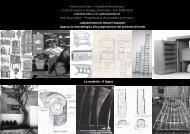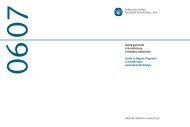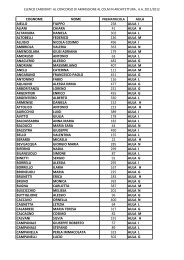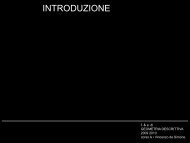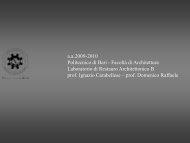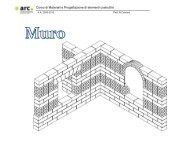Inoltre partico<strong>la</strong>re rilievo viene dato all’uso pertinent approach to professionalIstituzioni <strong>di</strong> geometria II + Istituzioni <strong>di</strong> <strong>di</strong>fferential calculus with more variables,ContentsLaboratorio 2° <strong>di</strong> Archeologiafinalizzata al<strong>la</strong> comprensione delcontatto con il mondo greco – Società ee all’interpretazione del<strong>la</strong> cartografia practice.matematica IIequilibrium con<strong>di</strong>tions and the study ofRiemann Integrals for functions in aArchaeology Design Stu<strong>di</strong>o 2nd year linguaggio formale dell’arte etrusca e cultura artistica in età orientalizzante – Iltra<strong>di</strong>zionale e al GIS per <strong>la</strong> costruzione <strong>di</strong> Moreover a particu<strong>la</strong>r importance will be Institutions of geometry 2 +evolution phenomena, variation criteria ofvariable. Integration methods.all’appren<strong>di</strong>mento dei fondamenti del<strong>la</strong> periodo arcaico e <strong>la</strong> tha<strong>la</strong>ssocrazia etrusca:un Sistema Informativo Territoriale.devoted to the use and interpretation of Institutions of mathematic 2optimization, forms optimization.Fundamental Theorem of Integral Calculus.lingua etrusca.re<strong>la</strong>zioni commerciali e conflitti politici –Articu<strong>la</strong>tion of educational activitiestra<strong>di</strong>tional cartography and the GIS for theAt the end of the course the student will beNumerical series and geometric series. - EtruscologiaAims and contentsUrbanistica e architettura nei centri urbaniThe course offers lessons and exercises. construction of a Geographic Information (Mat 05-9 cre<strong>di</strong>ti)able to solve or<strong>di</strong>nary <strong>di</strong>fferential equationsFunction with more variables. Limits and - EtruscologyPrimary course objective is to supply the – La scultura e <strong>la</strong> pittura tombale – La ‘crisi’The lessons will be arranged as follows: System.2° anno / corso annualeand multiple integrals.continuity. Differential calculus. Directionalnecessary and methodological instruments del V secolo - L’Etruria costiera e l’Etruria1. Introduction to urban p<strong>la</strong>nning:Area <strong>di</strong>dattica X:The aim of this course is to give thederivatives. Reimann Integrals for functions L-ANT/07 - 3 cfuto comprehend the main themes of the interna. – La recezione dell’arte c<strong>la</strong>ssica.4 Scienze matematiche per l’architettura44. I rego<strong>la</strong>menti <strong>di</strong>dattici88definitions and lexical issues2-3. Elements of history of the city4. basis of <strong>di</strong>scipline statute: the origins ofurban p<strong>la</strong>nning in XIX century: technicalefficiency, urban beauty, social equity.5. the meaning of City: urban limits, “big”and terrible cities, the cosmic, themechanicalism, the organic metaphors inurban theories6-7-8-9. The p<strong>la</strong>n: theories and practices,levels and scales of urban and regionalp<strong>la</strong>nning in Italy.10-11. “Materials” of urban projects:Housing; open spaces: streets, squares12-13. “Materials” of urban projects: openspaces: parks and gardens.14-15-16-17. From buil<strong>di</strong>ng recover to urbanand environmental renewal: the evolutionof urban renewal theory in Italy,Methodologies e practice of urban renewal,elements on so called ‘programmicomplessi’18-19-20. Environmental issue in urban andregional p<strong>la</strong>nning: from the limits of growthto sustainable development, theenvironmental system and the ‘statuto deiluoghi’.21. Final considerations.The exercises (to know how to do) will bedevoted to get the urban p<strong>la</strong>nning designtools and techniques needed for aIscrizione al corsoLe iscrizioni avvengono obbligatoriamentesul<strong>la</strong> piattaforma entro i primi <strong>di</strong>eci giornidall’inizio dei corsi.Modalità d’esameL’esame consisterà:- nel<strong>la</strong> esposizione in<strong>di</strong>viduale degliargomenti trattati durante lo svolgimentodelle lezioni (sapere);- nel<strong>la</strong> verifica degli esiti dell’attivitàapplicata e degli esoneri (saper fare).Giuseppe Devil<strong>la</strong>novaFinalità e contenuti <strong>di</strong>sciplinariIl corso si propone <strong>di</strong> fornire le conoscenzeprincipali sul<strong>la</strong> teoria dell’integrazione <strong>di</strong>Riemann, sulle serie numeriche, ponendopartico<strong>la</strong>re riguardo alle serie geometriche;verranno introdotti inoltre strumenti <strong>di</strong>calcolo <strong>di</strong>fferenziale <strong>di</strong> più variabili,con<strong>di</strong>zioni <strong>di</strong> equilibrio e stu<strong>di</strong>o <strong>di</strong>fenomeni <strong>di</strong> evoluzione, criteri variazionali<strong>di</strong> ottimizzazione, ottimizzazione <strong>di</strong> forme.Al termine del corso, lo studente avràacquisito i meto<strong>di</strong> concettuali e <strong>di</strong> calcoloper <strong>la</strong> risoluzione <strong>di</strong> alcune equazioni<strong>di</strong>fferenziali or<strong>di</strong>narie e per il calcolo <strong>di</strong>alcuni integrali multipli.Obiettivo del corso è quello <strong>di</strong> fornire allostudente , insieme agli elementi del calcolo<strong>di</strong>fferenziale e integrale, una metodologia<strong>di</strong> <strong>la</strong>voro che lo avvii, da un <strong>la</strong>to adutilizzare criticamente gli strumentiacquisiti, dall’altro a collegare i contenutidel<strong>la</strong> matematica alle successive <strong>di</strong>sciplinestrutturali.Aims and contentsThe course provides the basic elementsabout Reimann integral theory, numericalseries, in particu<strong>la</strong>r geometric series,students good methods to apply thelearned notions in practise and to joinmathematics instruments to the structural<strong>di</strong>sciplines they will study in the future.PrerequisitiContenuti del programma <strong>di</strong> Istituzioni <strong>di</strong>Matematiche I.PrerequisitesContents of “Istitution of Mathematics I”programm.Artico<strong>la</strong>zione delle attività <strong>di</strong>datticheIl corso prevede lezioni ed esercitazioni.Articu<strong>la</strong>tion of educational activitiesThe course consists of lessons andexercises.Temi del corsoIntegrali <strong>di</strong> Riemann per funzioni in unavariabile. Meto<strong>di</strong> <strong>di</strong> integrazione. Teoremafondamentale del Calcolo dell’integrale.Serie numeriche e serie geometriche.Funzioni in più variabili. Limiti e continuità.Calcolo <strong>di</strong>fferenziale. Derivate <strong>di</strong>rezionali.Integrali secondo Riemann per funzioni indue variabili. Domini normali. Formule <strong>di</strong>riduzione. Inversione dell’or<strong>di</strong>ne <strong>di</strong>integrazione. Formu<strong>la</strong> <strong>di</strong> cambiamento <strong>di</strong>variabili. Equazioni <strong>di</strong>fferenziali lineari acoefficienti costanti.with two variables. Normal dominions.Reduction formu<strong>la</strong>s. Inversion of the orderof integration. Formu<strong>la</strong> for change ofvariables. Linear <strong>di</strong>fferential equations withconstant coefficients.Iscrizione al corsoLe iscrizioni avvengono obbligatoriamentesul<strong>la</strong> piattaforma entro i primi <strong>di</strong>eci giornidall’inizio dei corsi. Per iscriversi lostudente deve avere sostenuto tutte lepropedeuticità previste.E’ ammessa l’iscrizione con riserva perquegli studenti che sosterranno tutte lepropedeuticità previste entro <strong>la</strong> sessioneinvernale.La mancata verifica <strong>di</strong> questa con<strong>di</strong>zioneimplica a febbraio l’automatica decadenzadell’iscrizione.Modalità d’esameEsame scritto ed orale.2° annoin<strong>di</strong>rizzo ‘c<strong>la</strong>ssico’Area <strong>di</strong>dattica XII:Discipline integrative <strong>di</strong> cultura umanisticaChiara Bernar<strong>di</strong>niFinalità e contenuti <strong>di</strong>sciplinariObiettivo primario del corso è fornire glistrumenti metodologici necessariall’inquadramento dei principali aspettidel<strong>la</strong> storia, del<strong>la</strong> società e del<strong>la</strong> culturaartistica degli Etruschi.La conoscenza degli eventi storici salientinell’ambito delle principali civiltà del bacinodel Me<strong>di</strong>terraneo nel corso del primomillennio aC, insieme al correttoinquadramento geografico <strong>di</strong> eventi eluoghi, costituisce, quin<strong>di</strong>, il presuppostofondamentale per <strong>la</strong> comprensione dellerealizzazioni artistiche del periodo in esame.L’appren<strong>di</strong>mento teorico riguarda le fasiprincipali del<strong>la</strong> civiltà etrusca dal<strong>la</strong> primaetà del ferro al<strong>la</strong> romanizzazione, <strong>la</strong>conoscenza del<strong>la</strong> documentazionearcheologica, <strong>la</strong> comprensione dei legamidell’arte etrusca con l’arte del<strong>la</strong> Grecia edel vicino Oriente.La componente applicativa consiste nel<strong>la</strong>lettura ed interpretazione del<strong>la</strong>documentazione archeologica ed epigraficaEtruscan history, society and artisticculture.The knowledge of the main historicalevents in the Me<strong>di</strong>terranean areathroughout the first millennium, togetherwith a correct geographical location ofevents and ancient sites, constitutes thefundamental prerequisite for a correctinterpretation of the artistic realizations ofthe examined period.The theoretical learning concerns theprincipal phases of the Etruscan historyfrom the Iron Age to the Roman conquest,the knowledge of the archaeologicaldocumentation, the comprehension of there<strong>la</strong>tionships between the Etruscan art andthe artistic tra<strong>di</strong>tion of Greek and NearEastern areas.The applications concern the rea<strong>di</strong>ng an<strong>di</strong>nterpretation of archaeologicalmonuments and epigraphic documentation,for a more complete understan<strong>di</strong>ng of theEtruscan art and a basic knowledge of theEtruscan <strong>la</strong>nguage.Argomenti delle lezioniLa storia e <strong>la</strong> documentazione archeologicaetrusca dall’età del ferro al<strong>la</strong>romanizzazione.La questione delle origini: fonti letterarie edati linguistici – La cultura vil<strong>la</strong>noviana – Il– La ‘rinascita’ <strong>di</strong> IV secolo e le lotte conRoma. – L’artigianato artisticoIl pensiero scientifico e religioso. – Le<strong>di</strong>vinità <strong>di</strong> culto – Il sistema cosmico el’organizzazione dello spazio - I santuari: lestrutture architettoniche, i programmidecorativi e le pratiche cultuali nei santuarietruschi tra arcaismo e primo ellenismo.TopicsEtruscan history and archaeologicaldocumentation from the Iron Age to theRoman conquest.The origins of the Etruscans: literary sourcesand linguistic arguments - The Vil<strong>la</strong>noviansand the origin of the city – The contacts withthe Greek world - Society frame and artisticrealizations in the Orientalizing period – TheArchaic period and the Etruscan rule over thesea: commercial re<strong>la</strong>tionships and politicalconflicts – Urban p<strong>la</strong>nning and architecture inthe Archaic cities – Sculpture and tombpainting – The ‘Fifth Century crisis’ – TheEtruscan cities on the shore and the regions ofthe interior – The contacts with the Greekc<strong>la</strong>ssical art – The fourth century revival andthe struggles against Rome – The Hellenisticart and artistic craftsman.The Etruscan scientific and religious thoughts.The Etruscan Pantheon – Cosmography andspatial organization – The sanctuaries: thecult buil<strong>di</strong>ngs, the architectural decoration4.2.9 Progetti <strong>di</strong>dattici del I ciclo del CdLm in Architettura89
and the rituals, from the Archaic to thefrequenza verrà rilevata nei mo<strong>di</strong> e nelle conoscenza del<strong>la</strong> documentazioneinterpretation of the archaeologicaldelle arti figurative nell’età <strong>di</strong> Costantino the F<strong>la</strong>vii: the urban programs, the portraits, rigorosamente <strong>di</strong>acronica, esercitazioni 4.2.10 Progetti <strong>di</strong>dattici del II ciclo delHellenistic period.forme che il docente riterrà più opportuni. archeologica, infine al<strong>la</strong> comprensione dei documentation, for a more complex– Gli sviluppi del<strong>la</strong> pittura romana e del the reliefs – The development of roman bibliografiche, volte ad acquisire gliCdLM in ArchitetturaIn sede <strong>di</strong> esame sarà valutata <strong>la</strong>legami tra l’arte romana e <strong>la</strong> tra<strong>di</strong>zione understan<strong>di</strong>ng of the formal <strong>la</strong>nguage andmosaico tra II e IV secolo d.C.paintings in the 1° century a.D.- The urban art strumenti e <strong>la</strong> metodologia necessari a • 3° ANNO - 3rd YEARArtico<strong>la</strong>zione delle attività <strong>di</strong>dattiche conoscenza e <strong>la</strong> capacità <strong>di</strong> valutazione artistica italica, greca e delle singole of the articu<strong>la</strong>tion of the Roman art, andSecondo semestre: La documentazione of the middle empire: the monuments and the condurre ricerche bibliografiche, e <strong>di</strong>L’attività <strong>di</strong>dattica si articolerà in lezioni, storico-critica del<strong>la</strong> materia, attraverso un province romane.exercises in library, to acquire the tools andarcheologia nelle province romane.figurative arts in Trajan age, in Adrian age and lettura <strong>di</strong> un contesto archeologicoLaboratorio 3 <strong>di</strong> Progettazionedestinate ad affrontare <strong>la</strong> materia in forma colloquio integrato da lettura eLa componente applicativa riguarda sia fundamental methodologies ofCollocazione geografica e raggruppamenti in Antonine age - The Roman sarcophagi: finalizzate ad una più compiutaArchitettonicarigorosamente <strong>di</strong>acronica; esercitazioni interpretazione <strong>di</strong> immagini <strong>di</strong> materiali e l’esercizio al<strong>la</strong> lettura e l’interpretazione bibliographical research.territoriali delle province romane –typologies, p<strong>la</strong>ces of the production and the comprensione del linguaggio formale e Architectural Design Stu<strong>di</strong>o, 3rd yearbibliografiche, volte ad acquisire glicontesti archeologici.del<strong>la</strong> documentazione archeologica, permodalità <strong>di</strong> formazione delle varie province commerce - The urban programs and the dell’artico<strong>la</strong>zione dell’arte romana, viaggi4 44. I rego<strong>la</strong>menti <strong>di</strong>dattici90strumenti e <strong>la</strong> metodologia necessari acondurre ricerche bibliografiche, e <strong>di</strong>lettura <strong>di</strong> un contesto archeologicofinalizzate ad una più compiutacomprensione del linguaggio formale edell’artico<strong>la</strong>zione dell’arte etrusca; visite <strong>di</strong>istruzione, destinate ad integrare conl’esperienza <strong>di</strong>retta le cognizioni teoricheacquisite nell’ambito del corso.Articu<strong>la</strong>tion of educational activityThe educational activities are articu<strong>la</strong>ted inlectures in <strong>di</strong>achronic form, interpretingexercises of an archaeological context for amore complex understan<strong>di</strong>ng of the formal<strong>la</strong>nguage and articu<strong>la</strong>tion of the Etruscanart, bibliographical exercises to acquire thetools and necessary methodology to carryout bibliographical searches, educationaljourneys, intended to integrate with <strong>di</strong>rectexperience the theoretical knowledgeacquired within the course..Iscrizione al corsoLe iscrizioni avvengono obbligatoriamentesul<strong>la</strong> piattaforma entro i primi <strong>di</strong>eci giornidall’inizio dei corsi.Modalità d’esamePer sostenere l’esame è necessaria <strong>la</strong>frequenza del corso che consentel’acquisizione dei cre<strong>di</strong>ti previsti: tale- Archeologia e Storia dell’Arte Romana +Archeologia delle Province Romane- Archaeology and History of Roman Art +Archaeology of Roman ProvincesL-ANT/07 - 6 cfu2° anno / Corso annualein<strong>di</strong>rizzo ‘c<strong>la</strong>ssico’Area <strong>di</strong>dattica XII:Discipline integrative <strong>di</strong> cultura umanisticaRoberta BelliFinalità e contenuti <strong>di</strong>sciplinariObiettivo primario del corso è fornire glistrumenti metodologici necessariall’inquadramento dell’evoluzione del<strong>la</strong>civiltà romana attraverso i dati forniti dal<strong>la</strong>ricerca archeologica e tramite lo stu<strong>di</strong>odelle principali forme artistiche.La conoscenza degli eventi storici salientinell’ambito dell’età romana, insieme ad uncorretto inquadramento dei temi affrontatinelle re<strong>la</strong>tive coor<strong>di</strong>nate geografiche,costituisce, <strong>di</strong> conseguenza, il presuppostofondamentale per una correttainterpretazione delle realizzazioni artistichedel periodo in esame.L’appren<strong>di</strong>mento teorico è re<strong>la</strong>tivo alle fasiprincipali del<strong>la</strong> storia dell’arte romana, al<strong>la</strong>una più compiuta comprensione dellinguaggio formale e dell’artico<strong>la</strong>zionedell’arte romana; sia lo stu<strong>di</strong>o e l’attività <strong>di</strong>ricerca in biblioteca, volti ad acquisirestrumenti e metodologie fondamentali per<strong>la</strong> ricerca bibliografica.Aims and contentsPrimary course objective is to supply thenecessary and methodological instrumentsto comprehend the Roman civilizationorganization and evolution through thedata supplied by the archaeologicalresearch and through the study of the mainartistic forms.The knowledge of the main historicalevents in Roman age, together with acorrect arguments organization with theirre<strong>la</strong>tive geographical coor<strong>di</strong>nates,constitutes the fundamental prerequisitefor a correct interpretation of the artisticrealizations of the examined period.The theoretical learning concerns theprincipal phases of the history of theRoman art, the knowledge of thearchaeological documentation, eventuallythe comprehension of the re<strong>la</strong>tionshipsbetween the Roman art and the Italicartistic tra<strong>di</strong>tion, the Greek artistic tra<strong>di</strong>tionand the local ones of the <strong>di</strong>fferent Romanprovinces.The applications concerns the rea<strong>di</strong>ng andArgomenti delle lezioniLa storia dell’arte e <strong>la</strong> documentazionearcheologica a Roma e nelle provinceromane.Primo semestre: Archeologia e storiadell’arte romana: il contesto <strong>di</strong> Roma.Problematiche generali dell’archeologiaromana – Cronologia <strong>di</strong> riferimento –Caratteristiche generali e formazionedell’arte romana – La conquista delle cittàgreche e l’incontro con <strong>la</strong> cultura artisticagreca – L’arte dell’età repubblicana – Ilc<strong>la</strong>ssicismo e l’arte del primo impero: iprogrammi urbani, i complessimonumentali e l’arte dell’età <strong>di</strong> Augusto– Le produzioni artistiche dell’etàgiulio-c<strong>la</strong>u<strong>di</strong>a – Lo sviluppo del<strong>la</strong> pitturadell’età repubblicana e dell’età augustea –L’età dei F<strong>la</strong>vii: i programmi urbani, iritratti, i rilievi – Lo sviluppo del<strong>la</strong> pitturaromana nel I secolo d.C. – L’arte urbana delme<strong>di</strong>o impero: i monumenti e le artifigurative nell’età <strong>di</strong> Traiano, nell’età <strong>di</strong>Adriano, nell’età degli Antonini – Isarcofagi: tipologie, luoghi del<strong>la</strong>produzione e del commercio - L’arte urbananell’età dei Severi – Gli sviluppi delle artifigurative nel III secolo – L’arte urbananell’età del<strong>la</strong> Tetrarchia – La scultura inmarmi colorati: tipologie, luoghi del<strong>la</strong>produzione e del commercio – Caratteri– topografia e urbanistica delle provinceromane –– tra<strong>di</strong>zioni culturali e artistichelocali e <strong>la</strong> <strong>di</strong>ffusione dell’arte romana – ilproblema dell’arte provinciale – <strong>la</strong>documentazione archeologica piùsignificativa delle singole province – esameapprofon<strong>di</strong>to delle esperienze artistiche <strong>di</strong>una provincia romana: l’Achaia.Esercitazioni: lettura e interpretazione <strong>di</strong>immagini <strong>di</strong> contesti e documentiarcheologici <strong>di</strong> età romana, ricerchebibliografiche.Viaggi <strong>di</strong> stu<strong>di</strong>o.TopicsThe history of the art and the archaeologicaldocumentation in Rome and in the Romanprovinces.1st semester: Archaeology and history ofArt in Rome.Preliminar <strong>di</strong>scussion on general problemsabout Roman archaeology – Chronologyframe – General characters and formation ofthe Roman art - The conquest of the Greekcities and the meeting with the Greek culture- The art of the Republican age - Thec<strong>la</strong>ssicism and the art of the first empire: theurban programs, the monumental complexesand the figurative arts of the age of Augustus– The figurative arts of the age of theJulio-C<strong>la</strong>u<strong>di</strong>i – The paintings of the Republicanage and of the age of Augustus - The age offigurative arts in the Severan age - Thedevelopment of the figurative arts in the IIIcentury - The urban art in the age of theTetrarchism - The sculpture in colouredmarbles: typologies, p<strong>la</strong>ces of production andcommerce – General characters of thefigurative arts in Costantinian age– Thedevelopment of Roman paintings and mosaicbetween II and IV century a.D.2nd semester: Archaeology and History ofRoman art: the Roman provinces.Geographical position and territorialgroupings of the Roman provinces – historyand formation of the Roman provinces -topography and urbanistic of the romanprovinces - local cultural, artistic tra<strong>di</strong>tionsand phaenomena of Roman culture <strong>di</strong>ffusion- the problem of the provincial art - the moremeaningful archaeological documentation ofthe single provinces – deep examination ofthe artistic experiences of a Roman province:the Achaia.Exercises: rea<strong>di</strong>ng and interpretation ofimages regar<strong>di</strong>ng archaeological contexts anddocuments of Roman age, bibliographicalsearches.Instructing journeys.Artico<strong>la</strong>zione delle attività <strong>di</strong>datticheL’attività <strong>di</strong>dattica si articolerà in lezioni,destinate ad affrontare <strong>la</strong> materia in forma<strong>di</strong> istruzione, destinati ad integrare conl’esperienza <strong>di</strong>retta le cognizioni teoricheacquisite nell’ambito del corso.Articu<strong>la</strong>tion of educational activityLessons in <strong>di</strong>achronic form, interpretingexercises of an archaeological context for amore complex understan<strong>di</strong>ng of the formal<strong>la</strong>nguage and articu<strong>la</strong>tion of the Roman art,bibliographical exercises to acquire thetools and necessary methodology toconduct bibliographical searches,educational journeys, destined to integratewith <strong>di</strong>rected experience the theoreticalknowledges acquired within the course..Iscrizione al corsoLe iscrizioni avvengono obbligatoriamentesul<strong>la</strong> piattaforma e-learning entro i primi<strong>di</strong>eci giorni dall’inizio dei corsi.Modalità d’esamePer sostenere l’esame è necessaria <strong>la</strong>frequenza del corso che consentel’acquisizione dei cre<strong>di</strong>ti previsti: talefrequenza sarà rilevata nei mo<strong>di</strong> e nelleforme che il docente riterrà più opportuni.In sede <strong>di</strong> esame sarà valutata <strong>la</strong>conoscenza e <strong>la</strong> capacità <strong>di</strong> valutazionestorico-critica del<strong>la</strong> materia, attraverso uncolloquio integrato da lettura einterpretazione <strong>di</strong> immagini <strong>di</strong> materiali.L3PA-10 cfu3° anno / corso annualeArea <strong>di</strong>dattica I:Progettazione architettonica e urbana• Progettazione architettonica (Icar 14-7 cfu)•• Tecnica delle costruzioni A (Icar 14-3 cfu)Corso A• C<strong>la</strong>u<strong>di</strong>o D’Amato Guerrieri•• Domenico RaffaeleCorso B• Ariel<strong>la</strong> Zattera•• Vincenzo GiannuzziCorso C• Michele Beccu•• Domenico RaffaeleCorso D• Matteo Ieva•• Domenico RaffaeleCorso E• Calogero Montalbano•• Vincenzo Giannuzzi4.2.9 Progetti <strong>di</strong>dattici del I ciclo del CdLm in Architettura91




